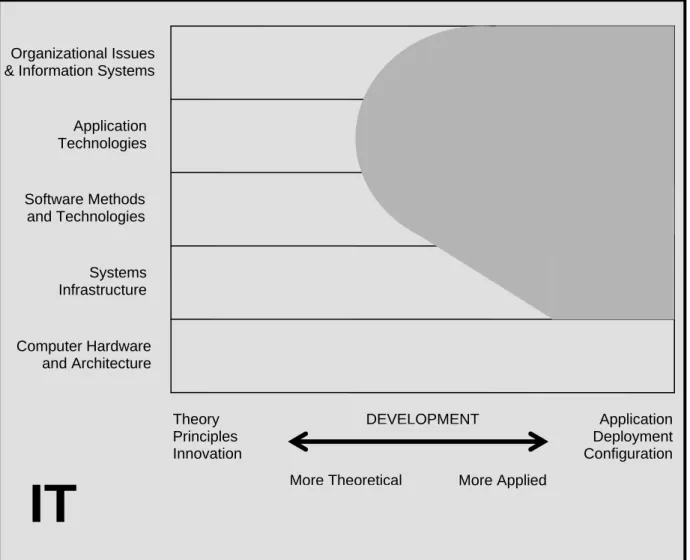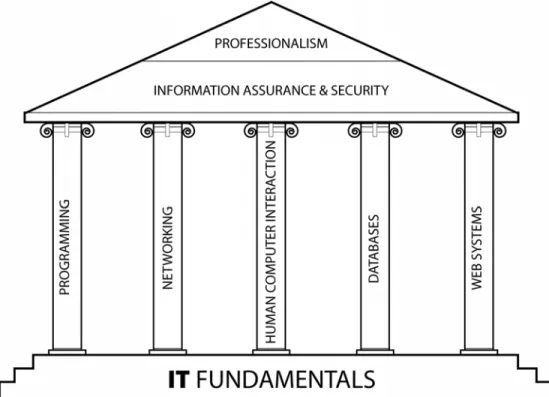This section of the report outlines a set of recommendations for four-year programs in information technology. Jacob Miller Pennsylvania College of Technology Williamsport, PA Han Reichgelt Southern Polytechnic State University Marietta, GA Members of the IT 4-Year Curriculum Committee: (in alphabetical order).
Introduction
- Overall structure of Computing Curricula 2005: The Overview Report
- Overview of the process for developing this IT volume
- Definition of Information Technology as an academic discipline
- Broad goals of an IT program
- Purpose and structure of this document
It is important to understand how this variation is represented in the description of the knowledge base. Because of the broad, integrative nature of IT, the core includes basic coverage of a high percentage of all units in the knowledge base (83 out of 88 units).
The Context of This Report
Historical background
At the SIGITE 2007 meeting (Sandestin, FL), it was decided to form a steering committee, consisting of two members of the writing committee (Barry Lunt and Joseph Ekstrom), plus one representative from ACM and one from IEEE-CS. The last meeting of the Writing Committee included the Steering Committee and representatives from the 2-Year Curriculum Committee and took place in Philadelphia, PA, in February 2008.
Evaluation of curriculum efforts
The Curriculum Committee began work on this document in December 2003, using the CS volume of the CC2001 document as a model. Comments were received and responded to until January 2007, when ACM received final feedback.
The Information Technology Discipline
- The emergence of Information Technology as a discipline
- Technical changes
- Pedagogical changes
- The role of Information Technology within the computing disciplines
- Characteristics of an IT graduate
- Research in IT
The academic discipline of Information Technology may well be characterized as the most integrative of the computing disciplines. Part of IT's role is to apply research from other computing disciplines.

Principles
This book should go beyond areas of knowledge to provide significant guidance for curriculum implementation. For such institutions, this book will only be effective if it defines a small set of sample models that assemble the knowledge units into reasonable, easy-to-implement courses.
Overview of the IT Body of Knowledge
Structure of the body of knowledge
- Core and advanced outcomes
- Assessing the time required to cover a unit
- Packaging units into courses
Each four-year program must include material relevant to advanced learning outcomes from the common knowledge. Core learning outcomes are not necessarily achieved in a set of introductory courses at the beginning of a four-year curriculum.
Summary of the IT body of knowledge
However, the time specifications should at least serve as a comparative measure, in that a 5-hour unit will likely take five times as long to cover as a 1-hour unit, regardless of the style of teaching. Appendix B includes two example ways in which the IT body of knowledge can be packaged into courses.
Overview of the Curricular Models
Overall structure of the model curricula
The role of experiential learning
However, in general, we believe that the most appropriate implementation of the curriculum proposed in this document requires a combination of different ways of providing experiential learning.
Overview of the implementation strategies
- Integration-first approach
- Pillars-first approach
The pillars-first approach introduces the details of the IT pillars first and provides the integration later in the curriculum. The integrated view, an important aspect of IT thinking, is developed in the latter courses in this list, where instructors can assume that students have a thorough grasp of the pillar material.
The Core in the Curriculum
- Overall philosophy
- Expectations of the introductory curriculum
- IT fundamentals
- Programming fundamentals
- Pervasive themes
- Presenting the core using the integration-first approach
- Presenting the core using the pillars-first approach
- The core at the advanced level
- Information Assurance and Security (IAS)
- Social and professional issues of IT
- The integrative capstone experience
- Other advanced materials
- IT pervasive themes
- Practicum in the IT curriculum
This can include most of the topics from the Fundamental Programming Constructs (PF2) module, along with some topics from Fundamental Data Structures (PF1) and Algorithms and Problem Solving (PF4). This approach also provides an early in-depth look into the pillars of the IT curriculum core.
Completing the Curriculum
General requirements
- The scientific method
- Familiarity with application domains
- Communication skills
- Working in teams
- Becoming a contributing member of society
- Pervasive themes in the IT curriculum
Few IT professionals can expect to work in isolation most of the time. One way to ensure that students learn these concepts is to weave them into the fabric of the core curriculum.
Advanced courses
These topics are essential concepts to include in the IT curriculum, but they do not fit neatly into one classroom. There is always the danger, however, that elements of pervasive themes take up so much time that they override the primary themes of the curriculum modules in which they are included.
Professional Practice
- Rationale
- Current practice in education
- Supporting professional practice
- The private and public sectors
- Modeling local and international work evironments
- Administration, faculty, and student roles
- Incorporating professional practice into the curriculum
- Assessing professional practice work
- Certifications
They participate in the development of accreditation guidelines that ensure the inclusion of professional practice in the curriculum [ABET2008-2009, CSAB2006]. Many courses outside of the IT department can help students develop a stronger professional practice.
Characteristics of IT Graduates
While security considerations are important for any computer professional, they become even more important for IT graduates. IT-based solutions are usually designed to address problems or opportunities that arise in a complex environment. IT graduates must be able to handle such complex situations and be able to focus on those aspects of the situation that are most relevant to the user and the wider context in which the user is expected to function.
The most appropriate conceptual tool for dealing with complexity is abstraction, and therefore IT graduates must develop the ability to use abstraction to form a model of the situation in which an IT-based solution is needed. and into which the IT-based solution is to be integrated. At the same time, IT graduates must have the skills and knowledge to use technology appropriately. However, IT graduates must also understand that very few IT-based solutions are designed and built from scratch.
Therefore, IT graduates must be able to use their technical expertise to integrate existing and new technologies. IT-based solutions are developed in teams, made up of people with different backgrounds, knowledge, skills and values. Furthermore, since IT graduates will often be the interface between users and technology, they must develop the ability to translate user language into technical language and vice versa.
Computing Across the Curriculum
Process questions
- Course specification
- Course design
- Course implementation
- Course assessment
Who should have primary responsibility for specifying the goals and content of a general education course in information technology. Alternatively, Information Technology departments may approach other departments with a proposal for a new course covering material not included in the existing curriculum. Will the course count for general education or distribution credit, major or minor credit in some program(s), or college electives.
Course design involves identifying explicit educational goals and objectives by specifying the technical skills and concepts to be included in the course curriculum and the educational outcomes that we want our students to have. Which specific information technology skills should be included in the course, and are these skills important and relevant for the field of study. What basic and ongoing information technology concepts should be included in the course and how these concepts relate to and support the information technology skills being taught.
What social and ethical issues, if any, should be included in the course to complement the technical material presented. How many points should the course be and how many times a week it meets. After the course has been offered once or twice, its design and implementation should be carefully reviewed and evaluated.
Course models
After implementation, a department is ready to offer the new general education course to the university community. The data needed for assessment can be collected in a number of ways: written student evaluations, classroom observations, and personal interviews with students and faculty from the client departments. When the course has been taught for a few years, it is also a good idea to interview candidates about the value of this course to their professional working environment.
If not, we should redesign it or simply remove it from the program and consider an alternative approach. Based on exam results and course evaluations, students who complete the course possess the required skills, knowledge and abilities. Designing and implementing a general education course is not a one-time process, but rather a "work in progress" that needs to be updated and modified as we gain additional experience.
Course design should involve regular reviews and redesigns, just as in the software development process. Such reviews are especially important in light of the rapidly changing nature of our field. Another example of this type of course is Integrative Programming, which is given in Appendix B under Pillars - The First Approach.
Institutional Challenges
The need for local adaptation
Principles for curriculum design
The need for adequate computing resources
Attracting and retaining faculty
Since there are too few teachers to meet the needs of the many students, one of the best ways to meet the rising demand from students is to involve those students in the educational process. Using students as course assistants not only helps to reduce the teaching deficit, but also provides a valuable teaching experience for the student assistants [Roberts95].
Faculty commitment to the degree program
Conclusion
A key component of the information technology discipline is understanding and advocating for the user in the development of IT applications and systems. Describe the symptoms of repetitive stress syndrome and list some approaches that can alleviate the problem. Explain and give examples of social engineering techniques used to gain access to computer and network resources in an organization.
Describe the user's role in information provision and how it fits into the overall information provision plan for the organization. The role of an IT professional is to develop, implement, manage and integrate data and information systems to support the organization. This knowledge area includes the collection, organization, modeling, transformation, presentation, safety and security of data and information.
Describe how Web services are used to integrate different applications in an organization: For example, describe the role of the WSDL, SOAP, and UDDI architectures in creating and using Web services. It is the role of IT professionals to select, design, implement, integrate and manage network and communication infrastructures in an organization. Describe the relationship between the static structure of the class and the dynamic structure of the instances of the class.
The role of the IT professional is to select, implement, integrate and manage platforms or components to support the organization's IT infrastructure. It is the role of IT professionals to design, select, deploy, implement and manage computer systems to support the organization. One of the roles of IT professionals is to design and build systems and integrate them into an organization.
Provide examples of current tools and methodologies for describing and evolving a company's different architectural visions.
